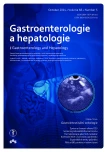Rehabilitation and modern approaches to the treatment of solitary rectal ulcer syndrome
Authors:
M. Smejkal 1; S. Adámek 1; P. Bitnar 2; J. Šťovíček 3; O. Polanecký 1; R. Lischke 1
Authors‘ workplace:
III. chirurgická klinika 1. LF UK a FN v Motole, Praha
1; Klinika rehabilitace a tělovýchovného lékařství 2. LF UK a FN v Motole, Praha
2
Published in:
Gastroent Hepatol 2014; 68(5): 451-455
Category:
Clinical and Experimental Gastroenterology: Case Report
doi:
https://doi.org/10.14735/amgh2014451
Overview
Solitary rectal ulcer syndrome is a rare pathology of the rectum. Apart from the traditional treatment methods, pharmacotherapy and surgical treatment, new rehabilitation methods have developed recently, having the potential to significantly improve the care for these patients.
Key words:
solitary rectal ulcer syndrome – rehabilitation – biofeedback
Supported by the project (Ministry of Health, Czech Republic) for conceptual development of research organization 00064203 (University Hospital Motol, Prague,Czech Republic).
The authors declare they have no potential conflicts of interest concerning drugs, products, or services used in the study.
The Editorial Board declares that the manuscript met the ICMJE „uniform requirements“ for biomedical papers.
Submitted:
16. 10. 2013
Accepted:
8. 9. 2014
Sources
1. Norton C, Chelvanayagam S. Methodology of biofeedback for adults with fecal incontinence: a program of care. J Wound Ostomy Continence Nurs 2001; 28(3): 156–168.
2. Martin CJ, Parks TG, Biggart JD. Solitary rectal ulcer syndrome in Northern Ireland. 1971–1980. Br J Surg 1981; 68(10): 744–747.
3. Tjandra JJ, Fazio VW, Church JM et al. Clinical conundrum of solitary rectal ulcer. Dis Colon Rectum 1992; 35(3): 227–234.
4. Alexander-Williams J. Solitary-ulcer syndrome of the rectum. Its association with occult rectal prolapse. Lancet 1977; 1(8004): 170–171.
5. Keighley MR, Williams NS et al. Surgery of the anus, rectum and colon. 3. ed.Philadelphia: Saunders Elsevier 2008; 1 : 829–845.
6. Meurette G, Regenet N, Frampas E et al. The solitary rectal ulcer syndrome. Gastroenterol Clin Biol 2006; 30(3): 382–390.
7. Horák L, Örhalmi J. Poruchy statiky a dynamiky malé pánve. In: Horák L, Skřička T, Šlauf P et al. Praktická proktologie. Praha: Grada publishing 2013.
8. Vaizey CJ, Roy AJ, Kamm MA. Prospective evaluation of the treatment of solitary rectal ulcer syndrome with biofeedback. Gut 1997; 41(6): 817–820.
9. Jarrett ME, Emmanuel AV, Vaizey CJ et al. Behavioural therapy (biofeedback) for solitary rectal ulcer syndrome improves symptoms and mucosal blood flow. Gut 2004; 53(3): 368–370.
10. Andromanakos NP, Kouraklis G, Alkiviadis K. Chronic perineal pain: current pathophysiological aspects, diagnostic approaches and treatment. Eur J Gastroenterol Hepatol 2011; 23(1): 2–7. doi: 10.1097/MEG.0b013e32834164f6.
11. Kolar P, Sulc J, Kyncl M et al. Stabilizing function of the diaphragm: dynamic MRI and synchronized spirometric assessment. J Appl Physiol 2010; 109(4): 1064–1071. doi: 10.1152/japplphysiol.01216.2009.
12. Allison M. Conservative management of faecal incontinence in adults. Nurs Stand 2010; 24(26): 49–56.
13. Hayden DM, Weiss EG. Fecal incontinence: etiology, evaluation, and treatment. Clin Colon Rectal Surg 2011; 24(1): 64–70. doi: 10.1055/s-0031-1272825.
14. Whitehead WE, Wald A, Norton NJ. Treatment options for fecal incontinence. Dis Colon Rectum 2001; 44(1): 131–142.
15. Galandiuk S, Roth LA, Greene QJ. Anal incontinence – sphincter ani repair: indications, techniques, outcome. Langenbecks Arch Surg 2009; 394(3): 425–433. doi: 10.1007/s00423-008-0332-4.
16. Moseley GL, Hodges PW, Gandevia SC. External perturbation of the trunk in standing humans differentially activates components of the medial back muscles. J Physiol 2003; 547(Pt 2): 581–587.
17. Hodges PW, Moseley GL. Pain and motor control of the lumbopelvic region: effect and possible mechanisms. J Electromyogr Kinesiol 2003; 13(4): 361–370.
18. Procházka R, Srna P, Frydrych J. Syndrom solitárního rektálního vředu. Gastroent Hepatol 2012; 66(4): 259–264.
Labels
Paediatric gastroenterology Gastroenterology and hepatology SurgeryArticle was published in
Gastroenterology and Hepatology

2014 Issue 5
- Metamizole vs. Tramadol in Postoperative Analgesia
- Metamizole at a Glance and in Practice – Effective Non-Opioid Analgesic for All Ages
- Metamizole in perioperative treatment in children under 14 years – results of a questionnaire survey from practice
- Obstacle Called Vasospasm: Which Solution Is Most Effective in Microsurgery and How to Pharmacologically Assist It?
- Possibilities of Using Metamizole in the Treatment of Acute Primary Headaches
Most read in this issue
- Inclusion of the FOLFIRINOX regimen in the treatment algorithm for metastatic pancreatic cancer – first experience
- Rehabilitation and modern approaches to the treatment of solitary rectal ulcer syndrome
- Expandable stents in the treatment of benign and malignant tumors of the esophagus
- Contrast enhanced endosonography in diagnosis of pancreatic cancer
